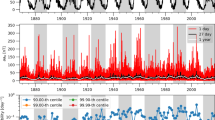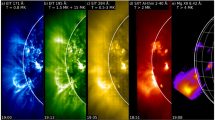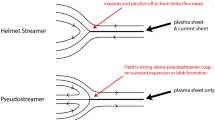Abstract
This paper reviews studies of the relationship between the evolution of vector magnetic fields and the occurrence of major solar flares. Most of the data were obtained by the video magnetograph systems at Big Bear Solar Observatory (BBSO) and Huairou Solar Observatory (HSO). Due to the favorable weather and seeing conditions at both stations, high-resolution vector magnetograph sequences of many active regions that produced major flares during last solar maximum (1989–1993) have been recorded. We have analyzed several sequences of magnetograms to study the evolution of vector magnetic fields of flare productive active regions. The studies have focused on the following three aspects: (1) processes which build up magnetic shear in active regions; (2) the pre-flare magnetic structure of active regions; and (3) changes of magnetic shear immediately preceding and following major flares. We obtained the following results based on above studies: (1) Emerging flux regions (EFRs) play very important roles in the production of complicated photospheric flow patterns, magnetic shear and flares. (2) Although the majority of flares prefer to occur in magnetically sheared regions, many flares occurred in regions without strong photospheric magnetic shear. (3) We found that photospheric magnetic shear increased after all the 6 X-class flares studied by us. We want to emphasize that this discovery is not contradictory to the energy conservation principle, because a flare is a three-dimensional process, and the photosphere only provides a two-dimensional boundary condition. This argument is supported by the fact that if two initial ribbons of a flare are widely separated (which may correspond to a higher-altitude flare), the correlation of the flare with strong magnetic shear is weak; if the two ribbons of a flare are close (which may correspond to a lower-altitude flare), its correlation with the strong shear is strong. (4) We have analyzed 18 additional M-class flares observed by HSO in 1989 and 1990. No detectable shear change was found for all the cases. It is likely that only the most energetic flares can affect the photospheric magnetic topology.
Similar content being viewed by others
References
Ai, G., Zhang, H., Li, W., Li, J., and Chen, J.: 1991, Chinese Sci. Bull. 36, 1275.
Akasofu, S.I.: 1984, Planetary Space Sci. 32, 1469.
Ambastha, A., Hagyard, M. J., and West, E. A.: 1993, Solar Phys. 148, 277.
Chen, J., Wang, H., Zirin, H., and Ai, G.: 1994, Solar Phys. 154, 261.
Chou, D. and Wang, H.: 1987, Solar Phys. 110, 81.
Forbes, T. G.: 1992, Proc. IAU Colloq. 141.
Gary, G. A., Hagyard, M. J., and West, E. A.: 1990, Solar Polarimetry, Proceedings of the Workshop on Solar Polarimetry, National Solar Observatory, Sacramento Peak, NM.
Hagyard, M. J.: 1984, NASA TM-86469.
Hagyard, M. J.: 1987, Artificial Satellites 22, 69.
Hagyard, M. J.: 1988, Solar Phys. 115, 107.
Hagyard. M. J. and Rabin, D. M.: 198G, Adv. Space Res. 6, 7.
Hagyard, M. J., Moore, R. L., and Emslie, A. G.: 1984, Adv. Space Res. 4, 71.
Hagyard, M. J., Venkatakrishnan, P., and Smith, J. B.: 1990, Astrophys. J. Suppl. 73, 159.
Hagyard, M. J., West, E. A., and Smith, J. E.: 1993, Solar Phys. 144, 141.
Hagyard, M. J., Smith, J. B., Teuber, D., and West, E. A.: 1984, Solar Phys. 91, 115.
Krall, K. R., Smith, J. B., Hagyard, M. J., West, E. A., and Cummings, N. P.: 1982, Solar Phys. 79, 59.
Kurokawa, H.: 1987, Solar Phys. 113, 259.
Lites, B. W. and Low, B. C.: 1997, Solar Phys., this issue.
Livi, S. H. B., Martin, S. F., Wang, H., and Ai, G.: 1989, Solar Phys. 121, 197.
Low, B. C.: 1977, Astrophys. J. 212, 234.
Low, B. C. and Nakagawa, Y.: 1975, Astrophys. J. 199, 237.
Machado, M. E. and Moore, R. L.: 1991, Proceedings of SCOSTEP International Solar-Terrestrial Physics Symposium, The Hague, The Netherlands.
Melrose, D. B.: 1995, Astrophys. J. 451, 391.
Moore, R. L., Hagyard, M. J., and Davis, J. M.: 1987, Solar Phys. 113, 347.
Moore, R. L., Hurford, G. J., Jones, H. P., and Kane, S. R.: 1984, Astrophys. J. 276, 379.
Neidig, D. F.: 1979, Solar Phys. 61, 121.
Sivarman K. R., Rausaria, R. R., and Aleem, S. M.: 1992, Solar Phys. 138, 353.
Tanaka, K.: 1991, Solar Phys. 136, 133.
Tang, F. and Wang, H.: 1993, Solar Phys. 143, 107.
Wang, H.: 1990, Solar Polarimetry, Proceedings of the Workshop on Solar Polarimetry, National Solar Observatory, Sacramento Peak, NM.
Wang, H.: 1992a, in K. Harvey (ed.), The Solar Cycle, Proceedings of the National Solar Observatory/ Sacramento Peak 12th Summer Workshop.
Wang, H.: 1992b, Solar Phys. 140, 85.
Wang, H.: 1992c, Solar Phys. 140, 41.
Wang, H. and Tang, F.: 1993, Astrophys. J. 407, L89.
Wang, H., Zirin, H., and Ai, G.: 1991, Solar Phys. 131, 53.
Wang, H., Zirin, H., Patterson, A., Ai, G., and Zhang, H.: 1989, Astrophys. J. 343, 489.
Wang, H., Tang, F., Zirin, H., and Ai, G.: 1991, Astrophys. J. 380, 282.
Wang, H., Ewell, W., Zirin, H., and Ai, G.: 1994, Astrophys. J. 424, 436.
Wang, H., Gary, D. E., Zirin, H., Nitta, N., Schwartz, R. A., and Kosugi, T.: 1996, Astrophys. J. 456
Zirin, H.: 1992, in J. T. Schmelz and J. T. Brown (eds.), The Sun, A Laboratory for Astrophysics, Kluwer Academic Publishers, Dordrecht, Holland, p. 449.
Zirin, H. and Tanaka, K.: 1973, Solar Phys. 32, 173.
Zirin, H. and Wang, H.: 1989, Solar Phys. 119, 245.
Zirin. H. and Wang, H.: 1990, Solar Phys. 125, 45.
Zirin, H. and Wang, H.: 1993a, Solar Phys. 144, 37.
Zirin, H. and Wang, H.: 1993b, Nature 363, 426.
Author information
Authors and Affiliations
Rights and permissions
About this article
Cite this article
Wang, H. ANALYSES OF VECTOR MAGNETOGRAMS IN FLARE-PRODUCTIVE ACTIVE REGIONS. Solar Physics 174, 163–173 (1997). https://doi.org/10.1023/A:1004980917354
Issue Date:
DOI: https://doi.org/10.1023/A:1004980917354




